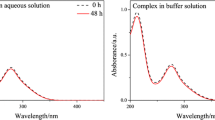Abstract
A new μ-oxamido-bridged copper(II)–copper(II) binuclear complex with formula of [Cu2(heap)](bipy)(ClO4)2, where H2heap and bipy are N,N′-bis(N-hydroxyethylaminopropyl)-oxamide and 4,4′-bipyridine, respectively, has been synthesized and characterized by elemental analyses, molar conductivity measurement, IR and electronic spectra studies, and single-crystal X-ray diffraction. The single-crystal X-ray analysis reveals that the complex has two embedded inversion centers at the mid-points of the C6–C6i bond of the oxamido group and the C7–C7ii bond of the 4,4′-bipyridine, respectively [symmetry code: (i) 2−x, 1−y, 1−z; (ii) =2−x, −y, 1−z]. Copper(II) atom is in a square-planar coordination geometry. The Cu···Cu separation through the oxamido birdge is 5.1430(8) Å. The bridging ligand (heap2−) adopts a bis-tetradentate trans conformation. A one-dimensional hydrogen bonding supramolecular structure parallel to the [2 1 0] direction is found in the crystal. The interaction of the binuclear copper(II) complex with herring sperm DNA (HS-DNA) was investigated by using absorption and emission spectra, electrochemical techniques and viscometry. The results suggest that the binuclear copper(II) complex interacts with HS-DNA by electrostatic interaction with intrinsic binding constant of 1.54 × 104 M−1.
Graphical Abstract
A new µ-oxamido-bridged copper(II)–copper(II) binuclear has been synthesized and characterized by single-crystal X-ray diffraction. The interaction of the binuclear copper(II) complex with herring sperm DNA (HS-DNA) was investigated.







Similar content being viewed by others
References
Chifotides HT, Dunbar KR (2005) Acc Chem Res 38:146
Bruijinin PC, Sadler PJ (2008) Curr Opin Chem Biol 12:197
Mancin F, Scrimin P, Tacilla P, Tonellato U (2005) J Chem Soc, Chem Commun 28(20):2540
Karlin KD, Tyeklar Z (1993) Bioinorganic Chemistry of Copper. Chapman & Hill, New York
Psomas G (2008) J Inorg Biochem 102:1798
Efthimiadou EK, Katsaros N, Karaliota A, Psomas G (2007) Inorg Chim Acta 360:4093
Gupta SK, Hitchcock PB, Kushwah YS, Argal GS (2007) Inorg Chim Acta 360:2145
Raman N, Jeyamurugan R (2009) J Coord Chem 62:2375
Jiang M, Li YT, Wu ZY, Liu ZQ, Yan CW (2009) J Inorg Biochem 103:833
Thomas AM, Neelakanta G, Mahadevan S, Nethaji M, Chakravarty AR (2002) Eur J Inorg Chem 2002(10):2720
Ojima H, Nonoyama K (1988) Coord Chem Rev 92:85
Sheldrick GM (1997) SHSLXL97, program for crystal structure refinement. University of Göttingen, Germany
Marmur J (1961) J Mol Biol 3:208
Reichmann ME, Rice SA, Thomas CA, Doty PJ (1954) J Am Chem Soc 76:3047
Barton JK, Goldberg JM, Kumar CV, Turro NJ (1986) J Am Chem Soc 108:2081
Chaires JB, Dattagupta N, Crothers DM (1982) Biochemistry 21:3933
Cohen G, Eisenberg H (1969) Biopolymers 8:45
Geary WJ (1971) Coord Chem Rev 7:81
Radecka-Paryzek W (1979) Inorg Chim Acta 34:5
Tang JK, Yang Y, Zhou HB, Li YZ, Liao DZ, Jiang ZH, Yan SP (2005) Cryst Growth Des 5(2):813
Cremer D, Pople JA (1975) J Am Chem Soc 97:1354
Lou JF, Li YT, Wu ZY, Wang DQ, Dou JM (2005) Acta Cryst C61:m400
Sun F, Li YT, Wu ZY, Song YL, Jiang M (2006) Acta Cryst C62:m584
Wolf A, Shimer GH Jr, Meehan T (1987) Biochemistry 26:6392
Jiang CW, Chao H, Li H, Ji LN (2003) J Inorg Biochem 93:247
Pyle AM, Rehmann JP, Meshoyrer R, Kumar CV, Turro NJ, Barton JK (1989) J Am Chem Soc 111:3051
Le Pecq JB, Paoletti C (1967) J Mol Biol 27:87
Li JH, Wang JT, Zhang LY, Chen ZN, Mao ZW, Ji LN (2009) J Coord Chem 62(11):1775
Xiao YN, Zhan CX (2002) J Appl Polym Sci 84:887
Indumathy R, Radhika S, Kanthimathi M, Weyhermuller T, Nair BU (2007) J Inorg Biochem 101:434
Stern O, Volmer M (1919) Z Phy 20:183
Mahadevan S, Palaniandavar M (1998) Inorg Chem 37:693
Rodriguez M, Bard AJ (1990) Anal Chem 62:2658
Carter MT, Rodriguez M, Bard AJ (1989) J Am Chem Soc 111:8901
Carter MT, Bard AJ (1987) J Am Chem Soc 109:7528
Satyanarayana S, Dabrowiak JC, Chaires JB (1992) Biochemistry 31:9319
Jin L, Yang P (1997) J Inorg Biochem 68:79
Li Y, Wu Y, Zhao J, Yang P (2007) J Inorg Biochem 101:283
Acknowledgments
This project was supported by the National Natural Science Foundation of China (No. 21071133), and the Natural Science Foundation of Qingdao City (No. 09-1-3-73-jch).
Author information
Authors and Affiliations
Corresponding authors
Additional information
Yu Yu and Xiao-Wen Li contributed equally to this work.
Rights and permissions
About this article
Cite this article
Yu, Y., Li, XW., Jiang, LY. et al. Synthesis, Structure and DNA-Binding Studies of Oxamido-Bridged Binuclear Copper(II) Complex: [Cu2(heap)](bipy)(ClO4)2 . J Chem Crystallogr 41, 959–965 (2011). https://doi.org/10.1007/s10870-011-0025-7
Received:
Accepted:
Published:
Issue Date:
DOI: https://doi.org/10.1007/s10870-011-0025-7




